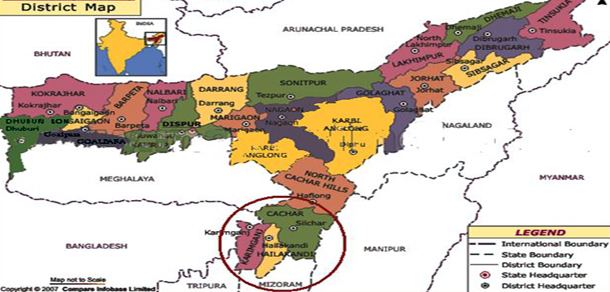 | ||
A spectacular journey aboard the barak valley exp part 1 feb 25 2013
The Barak Valley (Bengali: বরাক উপত্যকা), (also South Assam) is located in the southern region of the Indian state of Assam. The main city of the valley is Silchar. The region is named after the Barak river. The Barak valley mainly consists of three administrative districts of Assam State - namely Cachar, Karimganj, and Hailakandi. Among these three districts, Cachar and Hailakandi belonged to the erstwhile Cachar district in British India, whereas Karimganj belonged to the Sylhet District. Karimganj was separated from Sylhet after the 1947 referendum; with the rest of Sylhet falling under East Pakistan (now Bangladesh) and Karimganj under India.
Contents
- A spectacular journey aboard the barak valley exp part 1 feb 25 2013
- Silchar sealdah kanchanjungha express dream train of barak valley twin emd wdg4
- Etymology
- Language
- Religion
- Ethnic
- History
- Freedom Movement
- Post 1947
- Vegetation and wild life
- Constituencies
- Transportation and Communication
- Airways
- Railways
- Roadways
- Notable People
- References
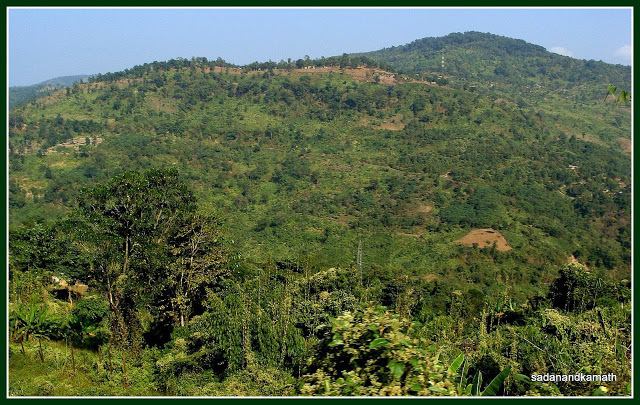
Silchar sealdah kanchanjungha express dream train of barak valley twin emd wdg4
Etymology
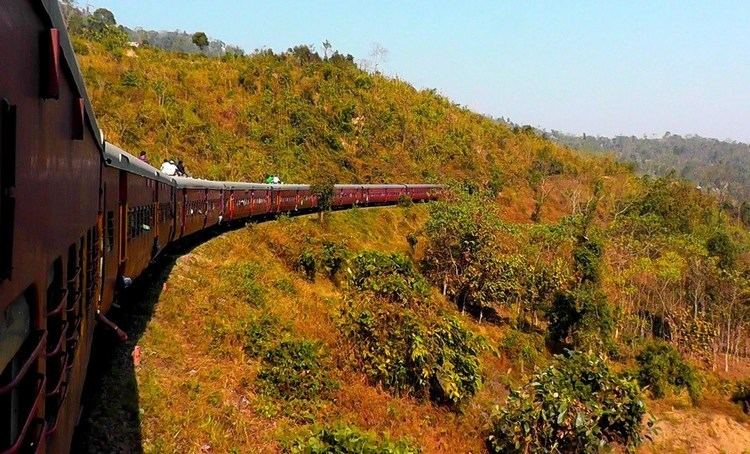
The name "Barak" has derived from the Dimasa words 'Bra' & 'Kro'. Bra means bifurcation and Kro upper portion/stream. The river Barak is bifurcated near Haritikar in the Karimganj district into Surma River and Kushiyara River. The upstream of this bifurcated river was called Brakro by the local Dimasa people. Over the years, Brakro got converted into Barak.
Language
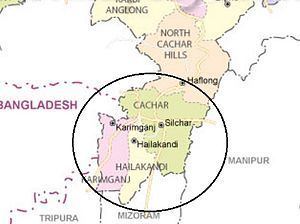
The official language of Barak valley is Bengali and English. The majority of the people are of Sylheti decent and they speak Sylheti language. Sylheti speaking people consider themselves as Indigenous of the valley
Religion
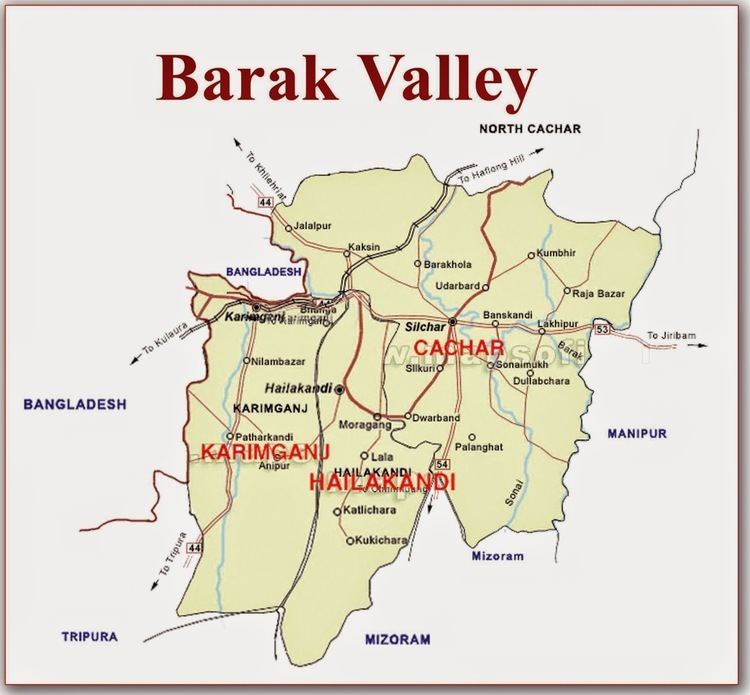
Hindusim is the majority religion in Barak valley. Religious composition of the valley population according to Census report of 2011 is Hindus:50.0% (18,12,141) ,Muslim:48.1% (17,44,958), Christians 1.6% (58,675) and others 0.2%. Barak Valley is second place in India after Kashmir Valley where Muslims are in second largest minority groups after Hindus. Hindus are majority in Cachar district(60%) while Muslims are majority in Hailakandi district(60.31%) and Karimganj district (56.26%).
Ethnic
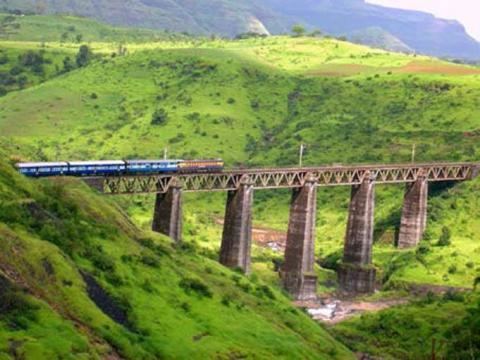
Apart from Sylhetis, Barak Valley is also the homeland of Bengalis, Dimasas, Manipuris (Both Bishnupriya and Meitei, Rongmei Nagas, and tea garden labourers) and some Hmar groups. Of the three districts, Hailakandi District and Karimganj District have Muslim majority while Cachar have Hindu majority.
History
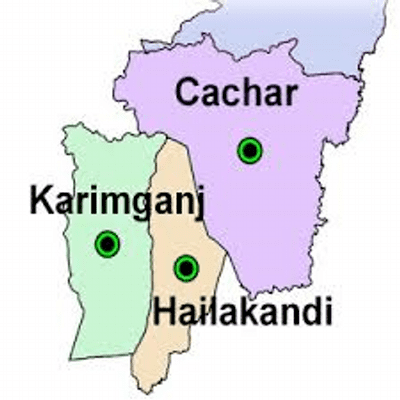
The region was originally part of the Tripura kingdom, which was annexed by Chilarai in the 16th-century to the Koch kingdom and administered by his half-brother Kamalnarayan. After the death of Nara Narayan, the kingdom, which came to be called the kingdom of Khaspur, became independent and was ruled by the descendants of Kamalnarayan. In the 17th-century, the last Koch ruler's daughter married the king of the Kachari kingdom, and the rule of Khaspur passed into the hands of the Kachari rulers, who eventually moved their capital from Maibang to Khaspur. The Kachari kingdom was annexed to British-India in 1832.
However, the dominance of Mughal Empire in Karimganj and Hailakandi finally ended with the introduction of British rule in Bengal. The undivided Cachar district (which also includes presently known as Hailakandi district) was included to Assam by British Rulers in 1832. The headquarters of the district was Silchar. The British Companies established a very large number of Tea Gardens (total 157) in the area and Silchar emerged as a very important center in this part of the country. All modern were introduced to the region in early twentieth century.
In 1947, when a plebiscite was held in Sylhet, the district was divided into two; the eastern part of Sylhet which is known as Karimganj remained with India whereas the other part fell under Bangladesh. Geographically the region is surrounded by hills from all three sides except its western plain boundary with Bangladesh. Nihar Ranjan Roy, author of Bangalir Itihash, says that "South Assam / Northeastern Bengal or Barak Valley is the extension of the Greater Surma/Meghna Valley of Bengal in every aspect from culture to geography".
Freedom Movement
In the undivided Surma Valley of which Barak valley was sort of an extension had leaders such as Basanta Kumar Das and Abdul Matin Choudhury, who actually represented Sylhet. In the Barak Valley region, it was Kamini Kumar Chanda, Arun Kumar Chanda and Abdul Matlib Mazumdar. Kamini Kumar Chanda died well before the eve of independence, but his son Arun Chanda and Abdul Matlib Mazumdar continued to fight for the cause. While Chanda was instrumental in garnering support of the Bengali Hindua, Mazumdar was one of the prominent Muslim leaders of eastern India to oppose the partition of India on communal lines. Mazumdar along with Fakhruddin Ali Ahmed (who later became the 5th President of India) became the most prominent Muslim opponents of the demand for a separate Muslim state of Pakistan, especially in the eastern part of the country. To counter the rising popularity of Muslim League, he successfully organised the Jamiat Ulema-e-Hind movement in Assam. Jamiat was an ally of the Congress having a mass following among the nationalist Muslims. In the very crucial 1946 General Elections just on the eve of India’s independence, he wrested the Muslim majority Hailakandi seat from the hold of Muslim League. That victory virtually sealed the hopes and aspirations of the Muslim League to include southern Assam including Cachar in Pakistan. It may be mentioned here that in that election, the bulk of the Muslim nominees of the Indian National Congress including Fakhruddin Ali Ahmed (5th President of India in later years) had lost to their Muslim League rivals miserably.
Assam's Surma Valley (now partly in Bangladesh) had Muslim-majority population. On the eve of partition, hectic activities intensified by the Muslim League as well Congress with the former having an edge. A referendum had been proposed for Sylhet District (now in Bangladesh). Mazumdar along with Basanta Kumar Das (then Home Minister of Assam) travelled throughout the valley organising the Congress and addressing meetings educating the masses about the outcome of partition on the basis of religion. On 20 February 1947 Moulvi Mazumdar inaugurated a convention – Assam Nationalist Muslim's Convention at Silchar. There after another big meeting was held at Silchar on 8 June 1947. Both the meetings, which were attended by a large section of Muslims paid dividend. He was also among the few who were instrumental in retaining the Barak Valley region of Assam, especially Karimganj with India. Mazumdar was the leader of the delegation that pleaded before the Radcliffe Commission that ensured that a part of Sylhet (now in Bangladesh) remains with India despite being Muslim-majority (present Karimganj district).[11]. Arun Kumar Chanda did not join Bordoloi cabinet in 1946 but preferred to do social work as a legislator and also to uplift the premier educational institution, G.C. College. Unfortunately soon he died leaving a huge vacuum of an able Bengali Hindu leader with a secular bent of mind.
Post 1947
The entire eastern India was swept by violence just after India's partition and independence on 15 August 1947, scores of Hindus fled the newly created East Pakistan (now Bangladesh) for India, and Muslims fled Assam for East Pakistan. A large number of people lost their lives owing to violence, which resurfaced with more ferocity in 1950. Mazumdar, the only member from the present Barak Valley in the cabinet, along with his cabinet and party colleagues took up responsibility for the safety of both Hindus and Muslims in the valley, touring affected areas and arranging camps and rehabilitation for the refugees, organizing supplies and security.
In 1960s a prominent figure in Barak valley politics came in the form of Moinul Hoque Choudhury, who was a cabinet minister in Assam from 1957 to 1966. In 1971 he became the Industry minister of India under the Prime Ministership of late Indira Gandhi.
Vegetation and wild life
The vegetation in the valley is mostly Tropical evergreen and there are large tracts of Rainforests in the northern and southern-eastern parts of the valley, which are home to Tiger, Elephants, Malayan sun bear, Capped langur, hoolock gibbon, etc. The forests of Barak valley were once rich in wildlife but now vanishing due to human onslaught. Rare species found are Hoolock gibbon, Phayre's leaf monkey, Pig-tailed macaque, Stump-tailed macaque, Masked Finfoot, White-winged Wood Duck, etc. have been recorded.
The Asian elephant has already vanished from most of the valley. The southern part was also recommended as 'Dhaleswari' wildlife sanctuary. Barail is the only wildlife sanctuary of the Barak valley region. It was initiated by noted naturalist Dr Anwaruddin Choudhury, who originally hailed from this region in early 1980s. This sanctuary was ultimately notified in 2004. Hailakandi have Inner line reserve forest and Katakhal reserve forest.
Constituencies
Barak Valley has two Lok Sabha seats.
Transportation and Communication
Barak Valley suffers from poor means of communication due to landslides & flood induced by heavy rainfall, as well as earthquake.
Airways
The only airport of the whole valley is the Silchar Airport, located at Kumbhirgram. There are regular direct flights from Kolkata, Imphal and Guwahati to Silchar.
Railways
Barak Valley is covered by the Northeast Frontier Railways. The Valley is only connected to Lumding Jn. (central Assam) through single route Board gauge rail-line. The distance of 170 km . Currently two trains are operational in this route
Roadways
Valley is connected to rest of India and Capital city only through National Highway 6 (India), which passes through Indian state of Meghalaya. Private as well as ASTC buses are operational. Connecting Barak Valley to Guwahati, Shillong, Aizawl, Imphal and Agartala. A strong transport lobby in connivance with the dispur administration is not allowing the aforesaid states to have a better communication
